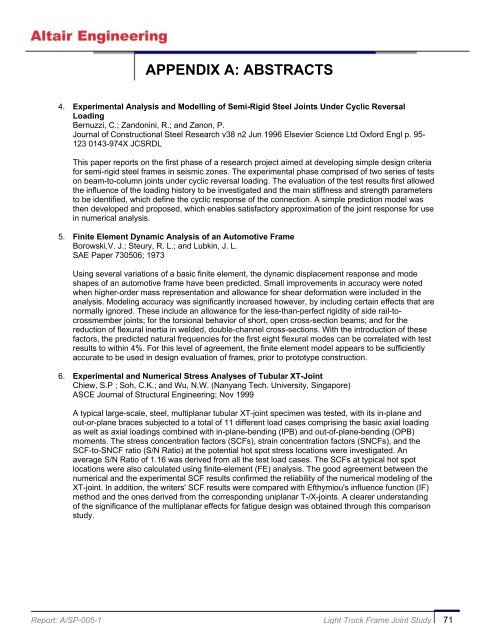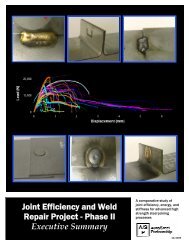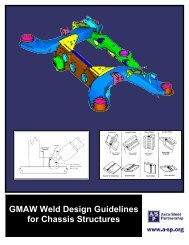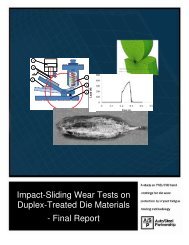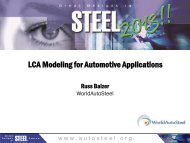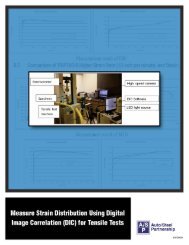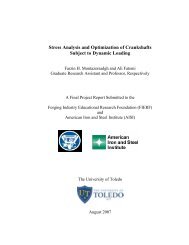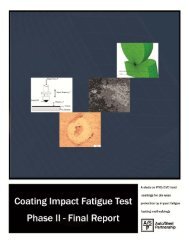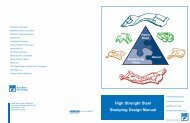Light Truck Frame Joint Stiffness Study Phase 1 Final Report
Light Truck Frame Joint Stiffness Study Phase 1 Final Report
Light Truck Frame Joint Stiffness Study Phase 1 Final Report
Create successful ePaper yourself
Turn your PDF publications into a flip-book with our unique Google optimized e-Paper software.
APPENDIX A: ABSTRACTS<br />
4. Experimental Analysis and Modelling of Semi-Rigid Steel <strong>Joint</strong>s Under Cyclic Reversal<br />
Loading<br />
Bernuzzi, C.; Zandonini, R.; and Zanon, P.<br />
Journal of Constructional Steel Research v38 n2 Jun 1996 Elsevier Science Ltd Oxford Engl p. 95-<br />
123 0143-974X JCSRDL<br />
This paper reports on the first phase of a research project aimed at developing simple design criteria<br />
for semi-rigid steel frames in seismic zones. The experimental phase comprised of two series of tests<br />
on beam-to-column joints under cyclic reversal loading. The evaluation of the test results first allowed<br />
the influence of the loading history to be investigated and the main stiffness and strength parameters<br />
to be identified, which define the cyclic response of the connection. A simple prediction model was<br />
then developed and proposed, which enables satisfactory approximation of the joint response for use<br />
in numerical analysis.<br />
5. Finite Element Dynamic Analysis of an Automotive <strong>Frame</strong><br />
Borowski,V. J.; Steury, R. L.; and Lubkin, J. L.<br />
SAE Paper 730506; 1973<br />
Using several variations of a basic finite element, the dynamic displacement response and mode<br />
shapes of an automotive frame have been predicted. Small improvements in accuracy were noted<br />
when higher-order mass representation and allowance for shear deformation were included in the<br />
analysis. Modeling accuracy was significantly increased however, by including certain effects that are<br />
normally ignored. These include an allowance for the less-than-perfect rigidity of side rail-tocrossmember<br />
joints; for the torsional behavior of short, open cross-section beams; and for the<br />
reduction of flexural inertia in welded, double-channel cross-sections. With the introduction of these<br />
factors, the predicted natural frequencies for the first eight flexural modes can be correlated with test<br />
results to within 4%. For this level of agreement, the finite element model appears to be sufficiently<br />
accurate to be used in design evaluation of frames, prior to prototype construction.<br />
6. Experimental and Numerical Stress Analyses of Tubular XT-<strong>Joint</strong><br />
Chiew, S.P ; Soh, C.K.; and Wu, N.W. (Nanyang Tech. University, Singapore)<br />
ASCE Journal of Structural Engineering; Nov 1999<br />
A typical large-scale, steel, multiplanar tubular XT-joint specimen was tested, with its in-plane and<br />
out-or-plane braces subjected to a total of 11 different load cases comprising the basic axial loading<br />
as welt as axial loadings combined with in-plane-bending (IPB) and out-of-plane-bending (OPB)<br />
moments. The stress concentration factors (SCFs), strain concentration factors (SNCFs), and the<br />
SCF-to-SNCF ratio (S/N Ratio) at the potential hot spot stress locations were investigated. An<br />
average S/N Ratio of 1.16 was derived from all the test load cases. The SCFs at typical hot spot<br />
locations were also calculated using finite-element (FE) analysis. The good agreement between the<br />
numerical and the experimental SCF results confirmed the reliability of the numerical modeling of the<br />
XT-joint. In addition, the writers' SCF results were compared with Efthymiou's influence function (IF)<br />
method and the ones derived from the corresponding uniplanar T-/X-joints. A clearer understanding<br />
of the significance of the multiplanar effects for fatigue design was obtained through this comparison<br />
study.<br />
<strong>Report</strong>: A/SP-005-1 <strong>Light</strong> <strong>Truck</strong> <strong>Frame</strong> <strong>Joint</strong> <strong>Study</strong> 71


